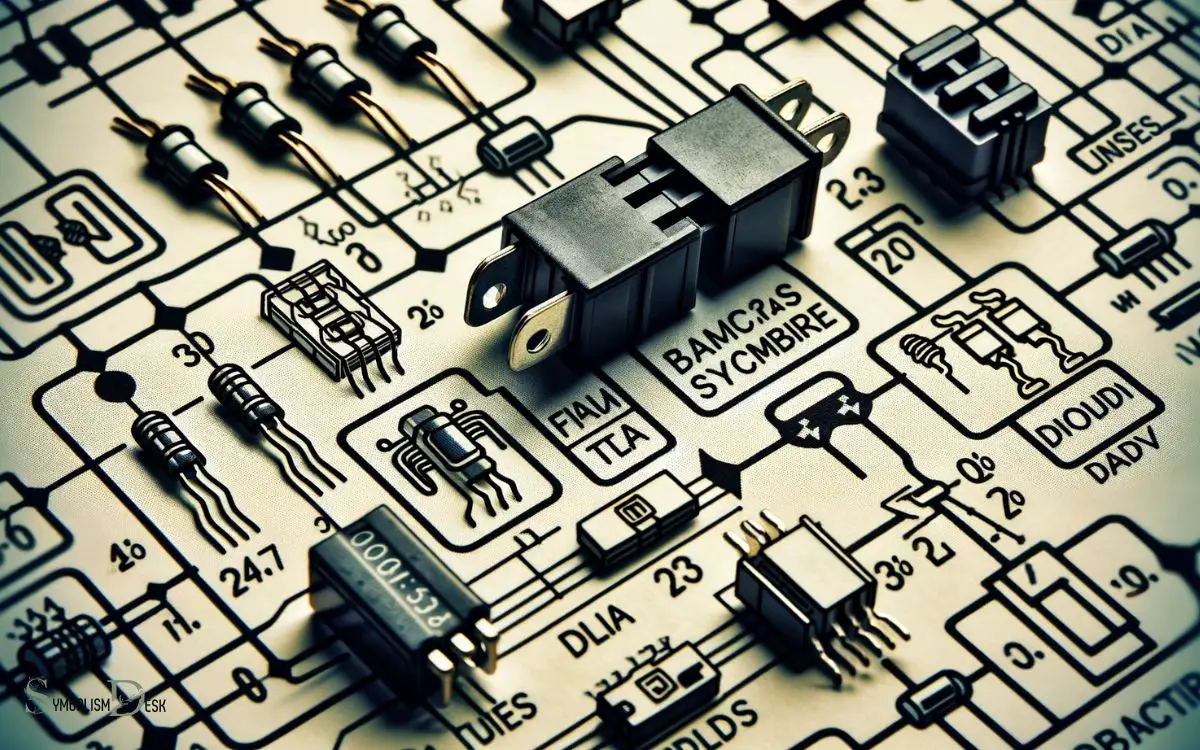Car Electrical Wiring Diagram Symbols: Knowledge is Power!
Car electrical wiring diagrams use standardized symbols to represent various components and connections in a vehicle’s electrical system.
These symbols facilitate understanding and troubleshooting by providing a visual representation of the system’s layout. Knowledge of these symbols is essential for automotive professionals and enthusiasts when working with vehicle wiring.
Car electrical wiring diagrams are akin to a road map for electrical circuits within a vehicle.
Here are common symbols you might encounter in these diagrams:
By learning these symbols, those working on car electrical systems can decipher the diagrams to diagnose issues or install new components.
Understanding car electrical wiring diagram symbols is like learning a new language that provides insights into the complex network of your vehicle’s electrical system.

Key Takeaway
Importance of Understanding Wiring Diagram Symbols

Understanding wiring diagram symbols is essential for troubleshooting and repairing car electrical systems. These symbols are the universal language of the automotive electrical world, enabling technicians to diagnose faults accurately and efficiently.
Without this knowledge, identifying components, their connections, and understanding how the system operates becomes a challenging task.
Wiring diagram symbols provide a visual representation of the electrical components and their interconnections, allowing technicians to comprehend complex electrical systems with ease.
By understanding these symbols, technicians can quickly locate faults, verify connections, and ensure that repairs are carried out accurately.
Commonly Used Basic Electrical Symbols
Commonly used basic electrical symbols play a crucial role in understanding and interpreting electrical diagrams. These symbols represent various components and connections within a circuit, providing a standardized way to communicate complex electrical information.
Understanding these symbols is essential for anyone working with electrical systems, as they are the building blocks for creating and interpreting circuit diagrams.

Key Electrical Symbols Explained
Exploring the key electrical symbols used in car electrical wiring diagrams provides a foundational understanding of vehicle electrical systems. The symbols convey crucial information about the connections, components, and wiring within a car’s electrical system.
Some commonly used basic electrical symbols include the resistor, capacitor, inductor, switch, relay, and more. The resistor symbol, for example, represents the resistance in a circuit, while the capacitor symbol signifies the storage of electrical energy.
The inductor symbol indicates the presence of an inductor in the circuit. Understanding these key electrical symbols is essential for diagnosing and repairing electrical issues in vehicles.
By familiarizing themselves with these symbols, individuals can effectively interpret and analyze car electrical wiring diagrams, enabling them to make accurate assessments and repairs within the vehicle’s electrical system.
Understanding Circuit Diagram Symbols
Basic electrical symbols are essential for interpreting car electrical wiring diagrams. Understanding these symbols is crucial for anyone working with car electrical systems.
Here are some commonly used basic electrical symbols:
- Resistor: Represents resistance in a circuit.
- Capacitor: Symbolizes the ability to store energy in an electric field.
- Battery: Depicts a power source in a circuit.
- Ground: Indicates the reference point in a circuit.
These symbols provide a visual representation of the various components and connections within a circuit, allowing individuals to comprehend and analyze the electrical systems in cars.
A clear understanding of these symbols is fundamental for diagnosing and repairing electrical issues in vehicles.
Application of Electrical Symbols
The application of electrical symbols in car electrical wiring diagrams is integral to accurately representing and understanding the components and connections within the vehicle’s electrical system.
Basic electrical symbols such as lines, circles, and various geometric shapes are used to depict different electrical components and their interconnections. For example, a straight line represents a conductor, while a zigzag line symbolizes a resistor.
Understanding these symbols is crucial for diagnosing and repairing electrical issues in vehicles. By using a standardized set of symbols, electrical diagrams enable technicians to interpret wiring schematics consistently, regardless of the vehicle’s make or model.
This facilitates efficient troubleshooting and repairs. Therefore, a comprehensive knowledge of commonly used basic electrical symbols is fundamental for anyone involved in the maintenance or repair of automotive electrical systems.
Advanced Electrical Symbols for Car Wiring Diagrams
When analyzing advanced electrical symbols for car wiring diagrams, understanding the meanings and usage of these symbols is crucial.
This includes recognizing the various components and their functions within the electrical system of the vehicle. Additionally, having tips for interpreting the diagrams can enhance the understanding of complex electrical systems in cars.

Symbol Meanings and Usage
Advanced electrical symbols for car wiring diagrams are crucial for an electrician’s understanding of the intricate circuitry in modern vehicles. These symbols convey specific information about the components and connections in a vehicle’s electrical system.
Here’s a list of advanced electrical symbols and their usage:
- Rotating Equipment Symbol: Represents components such as motors, generators, and alternators.
- Semiconductor Devices Symbol: Depicts various semiconductor devices like diodes, transistors, and integrated circuits.
- Transmission Path Symbol: Indicates the flow of electrical signals through wires, cables, and harnesses.
- Connection Point Symbol: Denotes the points where different components or wires are interconnected in the car’s electrical system.
Understanding these advanced electrical symbols is essential for accurately interpreting car wiring diagrams and diagnosing electrical issues in vehicles.
Diagram Interpretation Tips
Once electricians grasp the meanings and usage of advanced electrical symbols, they can effectively interpret car wiring diagrams by applying diagram interpretation tips. Understanding the flow of current in a circuit is crucial for accurate interpretation.
When analyzing a diagram, it’s important to identify power sources, such as batteries or alternators, and comprehend the direction of current flow indicated by the arrows in the circuit.
Additionally, recognizing the various types of connections, including series and parallel circuits, is essential for proper interpretation.
Advanced symbols like relays, solenoids, and different types of switches require a comprehensive understanding of their functions and representations in diagrams.
Interpreting Wiring Diagrams for Car Electrical Systems
An individual can interpret wiring diagrams for car electrical systems by familiarizing themselves with common symbols and understanding the flow of electrical circuits.

To do this effectively, they should:
- Study the key: Learn the meanings of symbols such as resistors, capacitors, diodes, and switches commonly used in car electrical wiring diagrams.
- Follow the current flow: Understand how the current travels through the various components in the circuit and how they interact with each other.
- Identify connections: Recognize where different wires intersect and connect, as well as where they diverge.
- Analyze the circuit logic: Grasp the sequence of operations and the logic behind the electrical systems, such as starting, lighting, or charging circuits.
Practical Application of Car Electrical Wiring Diagram Symbols
The application of car electrical wiring diagram symbols in practical scenarios is essential for troubleshooting and maintenance. Understanding and utilizing these symbols can greatly aid in the effective diagnosis and resolution of electrical issues in vehicles.

Here are four practical applications:
- Identifying Components: Symbols help in recognizing various components within the wiring system, such as resistors, capacitors, and switches.
- Tracing Circuits: By following the symbols in the diagram, technicians can trace the path of electrical circuits to locate faults or perform modifications.
- Standardization: Symbols ensure standardization across different vehicle models, simplifying the interpretation of wiring diagrams.
- Enhanced Efficiency: Proficiency in interpreting symbols leads to faster and more accurate troubleshooting, reducing vehicle downtime.
Mastering these symbols is crucial for automotive technicians and enthusiasts alike, enabling them to navigate complex electrical systems with precision and confidence.
Conclusion
Understanding car electrical wiring diagram symbols is crucial for ensuring the proper functioning of a vehicle’s electrical system. Did you know that 90% of electrical issues in cars can be traced back to faulty wiring or connections?
By familiarizing oneself with these symbols and using them effectively, car owners and mechanics can save time and money by troubleshooting and repairing electrical problems more efficiently.







